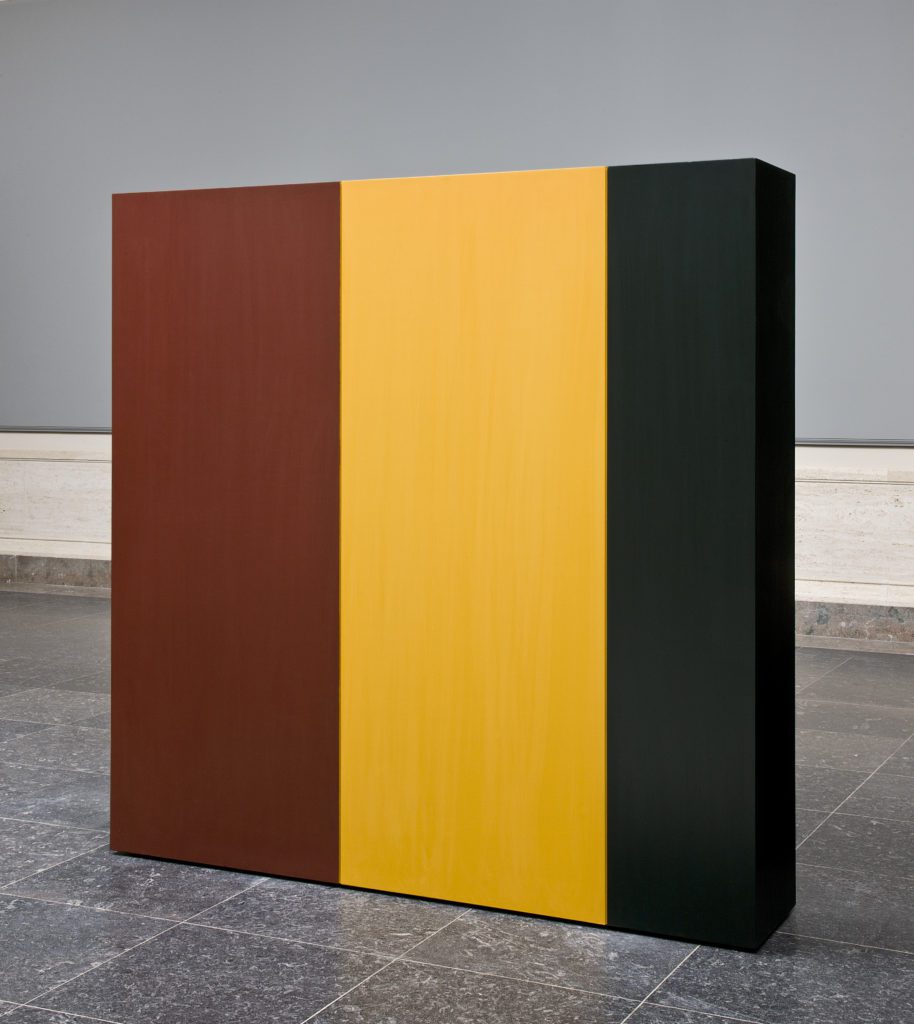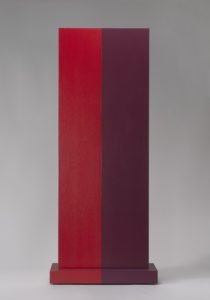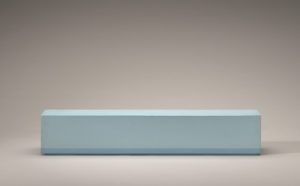Neighborhood Visionary: Anne Truitt at the National Gallery
By • December 6, 2017 0 1968

The National Gallery of Art is not your average neighborhood art gallery.
While part of the D.C. community, the National Gallery of Art is a colossal institution. On the entire American continent, it has few equals in the breadth, quality and sheer scale of its Western art holdings.
Its collections and exhibitions commonly promote the vanguard of art history: Giotto, da Vinci, Vermeer, El Greco, Monet, Picasso, Miró, Pollock, Newman. As such, it is rather unusual to find local artists within the gallery’s focus.
This is not to say that Washington has not or does not produce great artists. It is simply that Washington was never an international epicenter for the arts like New York, Paris, Vienna, Munich or Florence, all of which at some point fostered prodigious, groundbreaking artistic communities that shaped Western history.
In the rarified strata of mega-blockbuster museums that deal in the world’s most high- profile, significant and valuable collections of art, the featured artists tend largely to exist within the parameters of these traditions.
In a way, the National Gallery is unique among its peers because it was built in a city that has never existed in the art-historical spotlight.
New York’s Metropolitan Museum of Art could cite Rothko and Warhol in its cadre of local talent. The Louvre features untold artists who once had studios down the street. However, I doubt anyone in Paris thinks of Cézanne as just some local painter hanging in the gallery downtown.
That the sculptor Anne Truitt lived and worked in Washington, D.C., for virtually her entire career is not what makes “In the Tower: Anne Truitt,” on view through April 1, an outstanding exhibition. But for Washingtonians, it should be a point of pride.
Finding a map of Northwest D.C. on the wall of the National Gallery that pinpoints Truitt’s many local studios is an intimate, quietly thrilling moment of recognition. It is almost an affirmation, both for local patrons and supporters of the arts and for the passionate, tight- knit communities of artists that have always existed within the perimeter of the Boundary Stones, often unknown and unacknowledged. Since its foundation, they have used the National Gallery as a source of counsel, study and inspiration.
“Good art has been made here in Washington. That is one of the themes of our show,” says James Meyer, the National Gallery’s curator of art made between 1945 and 1974, who developed the exhibition.
A preeminent scholar of minimalist art, Meyer knew Truitt well. Beginning in 1997 and continuing until her death in 2004, he conducted a series of beautiful and extensive interviews with the artist in her Cleveland Park studio. (These interviews are a basis for the show’s in-gallery brochure.) Hearing him discuss Truitt and her relationship to Washington, one realizes that this exhibition was a long time coming.
“She was very interested in place, geography, topography and light,” Meyer says. “She talked about D.C. as cartographically in the middle of these two places, of her birthplace and her childhood home.”

Insurrection, 1962.
An Antipathy Toward the Brash
Truitt was born in Baltimore in 1921 and raised on Maryland’s Eastern Shore. She graduated from college with a degree in psychology in 1943, but left the field after working a few years as a nurse in Boston. Shortly thereafter, she returned to Washington, where she enrolled in courses at the Institute of Contemporary Art.
Coming of age in the 1950s amid a terrain of second-generation abstract expressionists, Truitt — like many minimalist artists, including her contemporary Donald Judd — developed an antipathy toward the brash, extravagant brushwork that had come to dominate contemporary art. “In a way, that makes her a true artist of the ’60s,” says Meyer. “She called that kind of painting ‘rhetorical.’”
On some level, the minimalist movement can be understood as a particular reaction against certain prevailing, increasingly tiresome trends in the American art scene. And though Truitt bristled at her association with minimalism, she in fact became an elegant practitioner of minimalist art. Her sculptures are freestanding wooden pillars, painted with a spare palette of rarely more than three colors, often just one.
Yet there is a personal language to Truitt’s work that transcends classification. She was a singular voice, an artist whose work exhibits an overwhelming delicacy, so specific to some untold time and place that it could be forged only from the recesses of consciousness, like the memory of some long-ago morning.
And so much of Truitt’s vision was born from her personal associations with the landscape and atmosphere of Washington and the Chesapeake region. There is a soft, Mid-Atlantic poetry to her drawings and sculptures, like austere, sun-bleached houses on a flat landscape that all but obliterate the horizon.
“It’s a refraction of a kind of perception that she developed growing up on the Eastern Shore,” says Meyer. “But it’s not figurative, not mimetic, not depicting. It is a severe abstraction that purges reference. But what Truitt might have admitted is that she experienced the architecture of the Eastern Shore as these bulking forms looming above her. She was nearsighted as a child and they hadn’t diagnosed it, so she experienced these buildings as shapes and light. So her sculptures can be seen as a kind of a refraction of her experience of architecture as a child. Of course, as she develops, her work gets more abstract and the references more latent. But it’s there.”

Parva Xii, 1977.
Many Studios in Washington
Significantly, the exhibition explores Truitt’s specific locational influences by tracking her studio migration around Washington. She had many studios in the nearly 50 years she lived and worked here, and different spaces permitted her to create different kinds of work.
In the mid-’50s, she shared a studio with two other artists in a tiny carriage house in Georgetown. All her work from this period is similarly small. She didn’t really begin to make sculptures until she moved into her Twining Court studio in Dupont Circle, across from what is now the Hotel Palomar. She inherited the space from Washington Color School visionary Kenneth Noland when he moved to New York City. In this carriage house, there was space to make a mess, to build structures and experiment with materials.
Truitt was a true studio artist and craftsperson at a time when studio practice and personal craft were being rejected by the intellectual elite. The major artists of this period — Donald Judd, Carl Andre, Dan Flavin — had abandoned the artist’s hand and turned away from the act of making, using industrial materials and hired technicians to construct their work directly on-site.
“What makes Truitt distinct among this field of artists is that she retained a studio practice,” Meyer says. “And strangely and fascinatingly enough, she did it right here in D.C.”
Meyer once asked her why she never moved to New York. Her answer: she couldn’t have a studio there.
“So it’s interesting to consider that Washington is organically a part of her art,” he says.
Her final studio in Cleveland Park, behind her house on 35th Street NW, is depicted in this show through a beautiful photograph, with soft light and heavy atmosphere, where her standing sculptures mirror the garden-like installation now in the gallery. “It was a kind of fisherman’s shack with beautiful light,” says Meyer, “as if it were in Easton.”
Memories Given Secret Forms
Truitt’s work is about her life, about what she saw and read and felt and thought. Through the names of her pieces — “Mary’s Light,” “Knight’s Heritage,” “Summer Remembered,” “Twining Court II” — their content becomes glancingly evident. Yet Truitt also strove toward a kind of objective form, as if to hide what she was looking back to for inspiration. They are memories given secret forms, dealing with her life in a way that is neither expressionistic nor confessional.
This also works to evoke unique associations in the viewer. “I honor the viewer,” she once told Meyer. “What she meant by that, I think, is that the viewer brings to the work what he or she will see in it,” he says.
I imagine there are many connections between Truitt’s art and her life in Washington. With a journalist for a husband and a network that included plenty of wealthy and influential Washingtonians — including Phil and Katharine Graham — she once described herself as “peripheral to the corridors of power.” But Truitt was discrete and, like her work, not particularly anecdotal. If you want to know the truth (whatever it may be), you will have to try wringing it from the veiled inner-workings of her craft.
Truitt is quoted, rather beautifully, as saying, “I want to hold life up and see what it is.”
Perhaps this explains the faintly prismatic effect of her sculptures, which reflect light around their cubic forms in a way that both absorbs and disperses the full range of her spartan color palettes — everything and nothing all at once. This exhibition, immaculately lit and installed with impeccably delicate precision, brings Truitt’s moving and historically significant work — created in Georgetown and nearby — to life.

